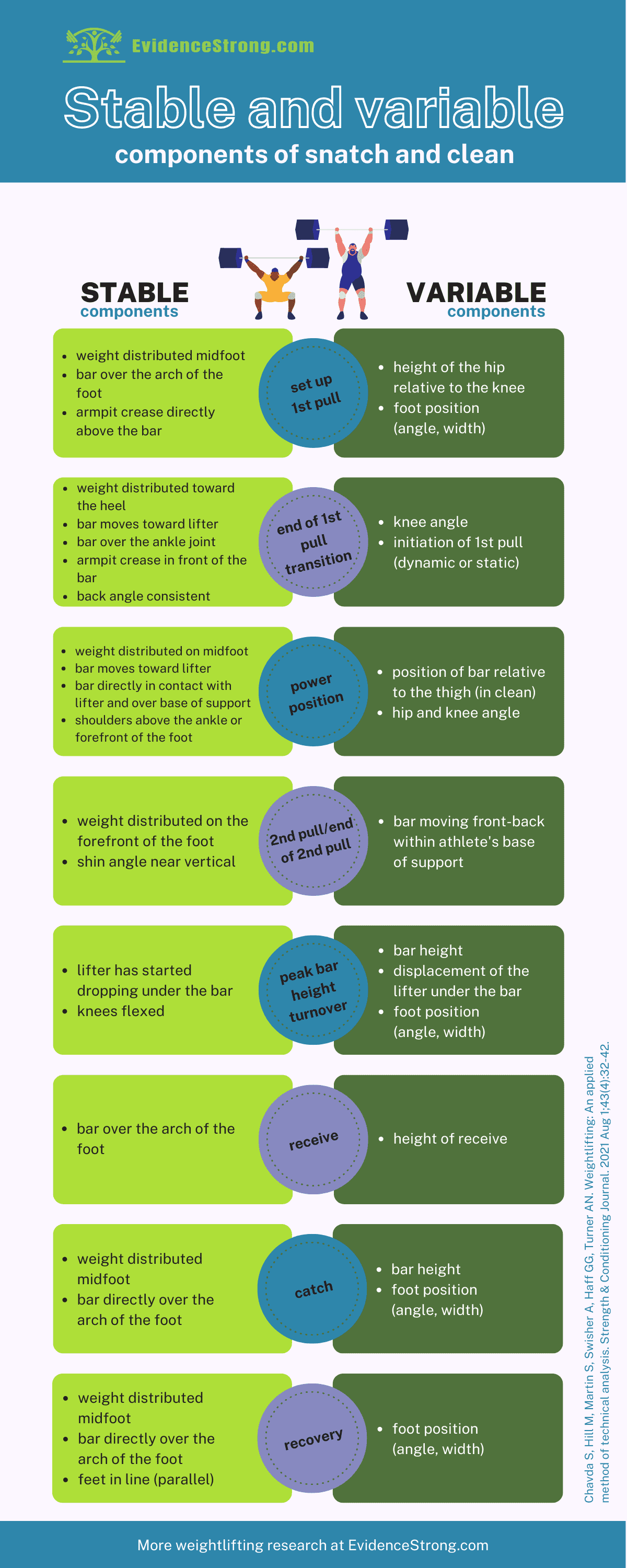Summary of a review article on the stable and variable technical components of snatch and clean.
Who
Olympic weightlifters
Design
Narrative review of the literature
Outcome measures
- technical elements of the snatch and clean
Main results
- Stable components - relate to join, center of pressure, barbell position relative to the body. These elements have to be preserved to make a lift.
- Variable components - relate to the athlete’s build and style of lifting. Variable components still need to meet the stable components.
Phase of the lift
set up/first pull
end of first pull/transition
power position
second pull/end of second pull
peak bar height/turnover
receive
catch
recovery
Stable components
Phase of the lift
set up/first pull
weight distributed midfoot
barbell over the arch of the foot
armpit crease directly above the barbell
barbell over the arch of the foot
armpit crease directly above the barbell
end of first pull/transition
weight distributed toward the heel
barbell moves toward lifter
barbell over the ankle joint
armpit crease in front of the barbell
back angle consistent
barbell moves toward lifter
barbell over the ankle joint
armpit crease in front of the barbell
back angle consistent
power position
weight distributed on midfoot
barbell moves toward lifter
barbell directly in contact with lifter and over base of support
shoulders above the ankle or forefront of the foot
barbell moves toward lifter
barbell directly in contact with lifter and over base of support
shoulders above the ankle or forefront of the foot
second pull/end of second pull
weight distributed on the forefront of the foot
shin angle near vertical
shin angle near vertical
peak bar height/turnover
lifter has started dropping under the barbell
knees flexed
knees flexed
receive
barbell over the arch of the foot
catch
weight distributed midfoot
barbell directly over the arch of the foot
barbell directly over the arch of the foot
recovery
weight distributed midfoot
barbell directly over the arch of the foot
feet in line (parallel)
barbell directly over the arch of the foot
feet in line (parallel)
Variable components
Phase of the lift
set up/first pull
height of the hip relative to the knee
foot position (angle, width)
foot position (angle, width)
end of first pull/transition
knee angle
initiation of first pull (dynamic or static)
initiation of first pull (dynamic or static)
power position
position of barbell relative to the thigh (in clean)
hip and knee angle
hip and knee angle
second pull/end of second pull
barbell moving front-back within athlete's base of support
peak bar height/turnover
barbell height
displacement of the lifter under the barbell
foot position (angle, width)
displacement of the lifter under the barbell
foot position (angle, width)
receive
height of receive
catch
barbell height
foot position (angle, width)
foot position (angle, width)
recovery
foot position (angle, width)
How it looks on camera
Phase of the lift
set up/first pull
1 frame before plate leaves the floor
end of first pull/transition
frame at which knee joint reaches maximal extension
frame before the shin angle moving away from the lifter
frame before the shin angle moving away from the lifter
power position
frame at with knee peak flexion (1st)
second pull/end of second pull
frame with peak knee extension
peak bar height/turnover
frame in which barbell is motionless
receive
frame before the barbell deforms/bends (if heavy enough)
catch
frame when lifter is the lowest in squat
recovery
frame at which lifter is motionless with the barbell fixed
Take home message
For a clinician & coach
Snatch and clean have some components that have to be executed a certain way (stable components) and some that can vary depending on lifter's anatomy and lifting style or preference (variable components). Making sure that all stable components are met will allow the lifter to lift the most weight.
For a parent
Snatch and clean have some components that have to be executed a certain way (stable components) and some that can vary depending on lifter's anatomy and lifting style (variable components). Making sure that all stable components are met will allow the lifter to lift the most weight.
For an athlete
Snatch and clean have some components that have to be executed a certain way (stable components) and some that can vary depending on lifter's anatomy and lifting style (variable components). Making sure that all stable components are met will allow the lifter to lift the most weight.
Interview with the author of the original article
Shyam Chavda is an experienced coach, technical tutor, and certified ASCC, CSCS, CES, and MSc in Applied Sport and Exercise Science professional at the London Sport Institute, Middlesex University. He has helped numerous athletes reach their full potential, including Cyrille Tchatchet, whom he coached on the refugee team at the Tokyo Olympics.
Original article
Chavda S, Hill M, Martin S, Swisher A, Haff GG, Turner AN. Weightlifting: An applied method of technical analysis. Strength & Conditioning Journal. 2021 Aug 1;43(4):32-42.

